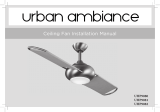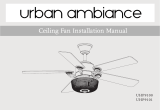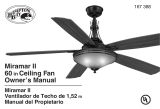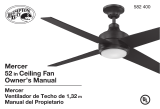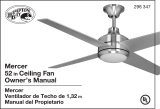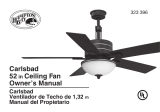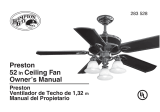Page is loading ...

Ceiling Fan Installation Manual
UHP9040
UHP9041
UHP9042
UHP9043

Table of Contents
Safety Rules.....................................................................................................................................................................................
Unpacking Your Fan .......................................................................................................................................................................
Installing Your Fan ..........................................................................................................................................................................
Installing the Light Kit.....................................................................................................................................................................
Operating Your Transmitter ..........................................................................................................................................................
Care of Your Fan ...........................................................................................................................................................................
Troubleshooting ............................................................................................................................................................................
Specifications ................................................................................................................................................................................
1.
2.
3.
9.
10.
11.
12.
13.

1. Safety Rules
1. To reduce the risk of electric shock, insure electricity has been turned off
at the circuit breaker or fuse box before beginning.
2. All wiring must be in accordance with the National Electrical Code and
local electrical codes. Electrical installation should be performed by a
qualified licensed electrician.
3.WARNING: To reduce the risk of electrical shock and fire, do not use
this fan with any solid-state fan speed control device.
4. WARNING: To reduce the risk of fire, electric shock, or personal injury,
mount to outlet box marked "Acceptable for Fan Support of 15.9 kg (35 lbs.)
Or Less" and use mounting screws provided with the outlet box. Most outlet
boxes commonly used for the support of light fixtures are not acceptable for
fan support and may need to be replaced. Due to the complexity of the
installation of this fan, a qualified licensed electrician is strongly
recommended.
WARNING
TO REDUCE THE RISK OF FIRE, ELECTRIC SHOCK OR PERSONAL
INJURY, MOUNT FAN TO OUTLET BOX MARKED ACCEPTABLE FOR
FAN SUPPORT.
5. The outlet box and support structure must be securely mounted and
capable of reliably supporting a minimum of 35 lbs (15.9 kg) or less.
Use only UL-listed outlet boxes marked FOR FAN SUPPORT.
6. The fan must be mounted with a minimum of 7 ft (2.1m) clearance from
the trailing edge of the blades to the floor.
7. To operate the reverse function on this fan, press the reversing button while
the fan is running.
8. Avoid placing objects in the path of the blades.
9. To avoid personal injury or damage to the fan and other items, be
cautious when working around or cleaning the fan.
10. Do not use water or detergents when cleaning the fan or fan blades. A
dry dust cloth or lightly dampened cloth will be suitable for most
cleaning.
11. After making electrical connections, spliced conductors should be
turned upward and pushed carefully up into the outlet box. The wires
should be spread apart with the grounded conductor and the
equipment-grounding conductor on one side of the outlet box.
12. Electrical diagrams are for reference only. Light kits that are not packed
with the fan must be UL Listed and marked suitable for use with the
model fan you are installing. Switches must be UL General Use
Switches. Refer to the Instructions packaged with the light kits
NOTE
READ AND SAVE ALL INSTRUCTIONS!
WARNING
TO REDUCE THE RISK OF PERSONAL INJURY, DO NOT BEND THE
BLADE ARMS (ALSO REFERRED TO AS BRACKETS) DURING
ASSEMBLY OR AFTER INSTALLATION. DO NOT INSERT OBJECTS IN
THE PATH OF THE BLADES.

Unpack your fan and check the contents. You should have the following items:
Unpacking Your Fan 2.
13. Loose parts bag containing:
a. Blade attachment hardware
(10 screws, 10 fiber washers )
b. Mounting hardware
Wire nuts (3)
1. Fan blades (3)
2. Canopy assembly
3. Ball/downrod assembly
4. Coupling cover
5. Set of blades bracket (3)
6. Fan motor assembly
7. Mounting plate
8. LED light kit
9. Trim Ring
10. Receiver with 6 wire nuts
11. Transmitter incl. 2 mounting screws
12. Balancing kit
3
1
28
9
4
5
6
710
12
13
ab
11

Tools Required
Phillips screw driver, straight slot screw driver,
adjustable wrench, step ladder, and wire cutters.
Mounting Options
If there isn't an existing UL listed mounting box,
then read the following instructions. Disconnect
the power by removing fuses or turning off
circuit breakers.
Secure the outlet box directly to the building
structure. Use appropriate fasteners and building
materials. The outlet box and its support must be
able to fully support the moving weight of the
fan (at least 35 lbs). Do not use plastic outlet
boxes.
Figure 4
Figure 3
Figure 1
Figure 2
Outlet box
Outlet box Outlet box
Note: You may need a longer downrod to
maintain proper blade clearance when installing
on a steep, sloped ceiling.
To hang your fan where there is an existing
fixture but no ceiling joist, you may need an
installation hanger bar as shown in Figure
4.
3. Installing Your Fan
WARNING
TO REDUCE THE RISK OF FIRE, ELECTRIC
SHOCK, OR OTHER PERSONAL INJURY,
MOUNT FAN ONLY TO AN OUTLET BOX
MARKED ACCEPTABLE FOR FAN SUPPORT
AND USE THE MOUNTING SCREWS
PROVIDED WITH THE OUTLET BOX. OUTLET
BOXES COMMONLY USED FOR THE
SUPPORT OF LIGHTING FIXTURES MAY NOT
BE ACCEPTABLE FOR FAN SUPPORT AND
MAY NEED TO BE REPLACED. CONSULT A
QUALIFIED ELECTRICIAN IF IN DOUBT.
Angled ceiling
maximum
18.5 angle
Recessed
outlet box
Provide strong support
Ceiling
hanger
bracket

4.
Hanging the Fan
REMEMBER to turn off the power. Follow
the steps below to hang your fan properly:
Step 1. Remove the decorative canopy bottom
cover from the canopy by turning the cover
counter clockwise.(Fig. 5)
Step 2. Remove the mounting bracket from
the canopy by removing the 1 of 2 screws
from the bottom of the mounting bracket and
loosening the other one a half turn from the
screw head. Next, turn the canopy counter
clockwise to removing the mounting bracket
from the canopy. (Fig. 5)
Step 3. Pass the 120-volt supply wires
through the center hole in the ceiling hanger
bracket as shown in Fig. 6.
Step 4. Secure the hanger bracket to the
ceiling outlet box with the screws and
washers provided with your outlet box.
Step 5. Remove the hanger pin, lock pin and
set screws from the top of the motor
assembly.
Step 6. Route wires exiting from the top of
the fan motor through the collar cover,
canopy cover, canopy and then through the
ball / downrod. (Fig. 7)
Step 7. Align the holes at the bottom of the downrod
with the holes in the collar on top of the motor
housing (Fig. 7). Carefully insert the hanger pin
through the holes in the collar and downrod. Be
careful not to jam the pin against the wiring inside the
downrod. Insert the locking pin through the hole near
the end of the hanger pin until it snaps into its locked
position, as noted in the circle inset of Fig. 7.
Step 8. Tighten two set screws on top of the fan
motor firmly. (Figure 7)
Step 9. Place the downrod ball into the hanger
bracket socket.
WARNING
FAILURE TO PROPERLY INSTALL
LOCKING PIN AS NOTED IN STEP 7
COULD RESULT IN FAN LOOSENING AND
POSSIBLY FALLING.
Ceiling
hanger
bracket
Ceiling
canopy
Canopy
cover
CUL Listed
electrical
box
Ceiling
hanger
bracket
Hook Washers
120V Wires
Mounting
screws
(supplied with
electrical box)
Ball/downrod
assembly
Ceiling
canopy
Motor wires Pin in locked
position
Tighten
screws
firmly
Locking pin
Canopy cover
Motor collar
Hanger pin
Collar cover
Figure 5
Figure 6
Figure 7

5.
Make the Electric
Connections
WARNING: To avoid possible electrical shock,
be sure electricity is turned off at the main fuse box
before wiring.
NOTE: This remote control unit is equipped with
16 code combinations to prevent possible
interference from or to other remote units. The
frequency switches on your receiver and
transmitter have been preset at the factory. Please
recheck to make sure the switches on the
transmitter and the receiver are set to the same
position, any combination of settings will operate
the fan as long as the transmitter and receiver are
set to the same position.(Figure 8)
Step 1. (Figure 9) Insert the receiver into the
mounting bracket with the flat side of the receiver
facing the ceiling.
Step 2. (Fig. 10) Motor to Receiver Electrical
Connections: Connect the Black wire from the fan
to Black wire marked "TO MOTOR L". Connect
the White wire from the fan to the White wire
marked "TO MOTOR N" from the receiver.
Connect the Blue wire from the fan to the Blue
wire marked "For Light" from the receiver. Secure
wire connections with the plastic wire nuts
provided.
Step 3. (Figure 10) Receiver to House Supply
Wires Electrical Connections: Connect the black
(hot) wire from the ceiling to the black wire
marked "AC in L" from the receiver. Connect the
white(neutral) wire from the ceiling to the white
wire marked "AC in N" f r o m t h e R e c e i v e r.
S e c u r e t h e w i r e connections with the plastic
wire nuts provided.
Step 4. (Figure 10) If your outlet box has a ground
wire (green or bare copper) connect it to the fan
ground wires; otherwise connect the hanging
bracket ground wire to the mounting bracket.
Secure the wire connection with a plastic nut
provided. After connecting the wires spread them
apart so that the green and white wires are on one
side of the outlet box and black and blue wires are
on he other side. Carefully tuck the wire
connections up into the outlet box.
NOTE: Fan must be installed at a maximum
distance of 20 feet from the transmitting unit for
proper signal transmission between the
transmitting unit and the fan's receiving unit.
Figure 9
Receiver
Hanger
bracket
Figure 8
Code switch
TM

Outlet box
Canopy
cover
Canopy
Hanger
bracket
Figure 11
Screws
6.
SUPPLY CIRCUIT
Ground
Conductor
Outlet Box
Green
Ground
Lead
Ground to
Downrod
BLACK
WHITE
WHITE
WHITE
WHITE
BLACK
BLACK
BLACK
BLUE
BLUE
GREEN
Figure 10
WHITE
WHITEBLACK
BLACK
Finishing the Installation
Step 1. Tuck connections neatly into ceiling outlet
box.
Step 2. Slide the canopy up to mounting bracket and
place the key hole on the canopy over the screw on
the mounting bracket, turn canopy until it locks in
place at the narrow section of the key holes. (Fig.
11)
Step 3. Align the circular hole on canopy with the
remaining hole on the mounting bracket, secure by
tightening the two set screws. Note: Adjust the
canopy screws as necessary until the canopy and
canopy cover are snug.
WARNING
Make sure the notch on the hanging bracket properly
sits in the groove in the hanger ball before attaching
the canopy to the bracket by turning the housing until
it drops into place.

7.
Attaching the Fan
Blades
CAUTION: Remove the 3 screws from the motor
support plate, discard the 3 screws and motor
support plate.
NOTE: Your fan blades are reversible. Select the
blade side finish which best accentuates your
decor.
Step 1. Attach the blades to the blade arms using
three screws and fiber washers as shown in Figure
12. Start a screw into the arm, do not tighten.
Repeat for the 2 remaining screws and washers.
Step 2. Tighten each screw securely starting with
the center screw. Make sure the blade is straight.
Step 3. Fasten the blade assembly to the motor
using the motor screws provided. (Figure 13)
Figure 13
Figure 12
Motor
Blade assembly
Screws
Fiber
washer
Screws
Blade arm
Blade

Figure 15
Mounting plate
Mounting ring
Screws
Installing the Mounting
Plate
Step 1.
Remove 1 of the 3 screws from the
mounting ring and loosen the other 2 screws.
(Do not remove)
Step 2.
Place the key holes on the mounting
plate over the 2 screws previously loosened from
the mounting ring, turn mounting plate until it
locks in place at the narrow section of the key
holes. Secure by tightening the 2 screws
previously loosened and the one previously
removed. (Fig. 15)
Blade Balancing
All blades are grouped by weight. Because
natural woods very in density, the fan may
wobble even though the blades are weighed
equally.
The following procedure should correct most
fan wobbling problems. Check after each step.
1. Check that all blade and blade arm screws are
secure.
2. Most fan wobbling problems are caused
when blade levels are unequal. Check this
level by selecting a point on the ceiling
above the tip of one of the blades. Measure
this distance as shown in Figure 14. Rotate
the fan until the next blade is positioned for
measurement. Repeat for each blade. The
distance deviation should be equal within
1/8".
3. Use the enclosed Blade Balancing Kit if the
blade wobble is still noticeable.
4. If the blade wobble is still noticeable,
interchanging two adjacent (side by side)
blades can redistribute the weight and
possibly result in smoother operation.
Touching
ceiling
Figure 14
WARNING
TO REDUCE THE RISK OF PERSONAL
INJURY, DO NOT BEND THE BLADE
HOLDERS WHILE INSTALLING,
BALANCING THE BLADES, OR CLEANING
THE FAN. DO NOT INSERT FOREIGN
OBJECTS BETWEEN ROTATING FAN
BLADES.
8.

9.
Installing the Light Kit
CAUTION: Before starting installation,
disconnect the power by turning off the circuit
breaker or removing the fuse at fuse box. Turning
power off using the fan switch is not sufficient to
prevent electric shock.
Step 1. Remove the two (2) Phillips headed
shoulder screws from the light kit mounting plate.
(Note: Do not remove the two torx head screws.)
(Fig. 16)
Step 2. While holding the LED light kit under
your fan, make the polarized plug connections:
- Blue to white
- Black to black
Step 3. Align the torx head screws in the light kit
with the two keyholes in the light kit pan.
Reinstall the two (2) Phillips head screws
previously removed into the threaded holes and
securely tighten. (Fig. 16)
Step 4. Align the trim ring onto the two (2)
Phillips screw heads on the light kit and turn
clockwise until snug. (Fig. 16)
Figure 16
Screws
Mounting
plate
Wire connector
LED
Light kit
Trim Ring
Installing the battery
Install 12V MN21/A23 battery (included), to prevent
damage to transmitter, remove the battery if not used
for long periods.
Figure 17

Operating Your Transmitter 10.
The Reverse switch is located on the motor
housing. Slide the switch to the Left for warm
weather operation. Slide the switch to the Right
for cool weather operation.
NOTE: Wait for fan to stop before changing the setting
of the slide switch.
Speed settings for warm or cool weather depend on
factors such as the room size, ceiling height, number of
fans, etc.
Warm weather - (Forward) A downward air flow
creates a cooling effect as shown in Figure 19. This
allows you to set your air conditioner on a higher
setting without affecting your comfort.
Cool weather - (Reverse) An upward airflow moves
warm air off the ceiling area as shown in Figure 20.
This allows you to set your heating unit on a lower
setting without affecting your comfort.
Figure 18
Restore power to ceiling fan and test for proper
operation.
1. " , , " buttons:
These three buttons are used to set the fan
speed as follows:
= Low speed
= Medium speed
= High speed
2. " " button:
This button turns the fan off.
3. The " " button turns the light ON or OFF and also
controls the brightness setting. Press and release the
button to turn the light ON or OFF. Press and hold the
button to set the desired brightness. The light key has an
auto-resume, it will stay at the same brightness as the
last time it was turned off.
Figure 19
Figure 20

11. Care of Your Fan
Here are some suggestions to help you maintain your
fan
1. Because of the fan's natural movement, some
connections may become loose.
Check the support
connections, brackets, and blade attachments
twice a year.
Make sure they are secure.
(It is not
necessary to remove fan from ceiling.)
2. Clean your fan periodically to help maintain its new
appearance over the years. Use only a soft brush or
lint-free cloth to avoid scratching the finish. The
plating is sealed with a lacquer to minimize
discoloration or tarnishing. Do not use water when
cleaning. This could damage the motor, or the wood,
or possibly cause an electrical shock.
3. You can apply a light coat of furniture polish to the
wood blades for additional protection and enhanced
beauty. Cover small scratches with a light application
of shoe polish.
4.
There is no need to oil your fan.
The motor has
permanently lubricated bearings.
IMPORTANT
MAKE SURE THE POWER IS OFF AT THE
ELECTRICAL PANEL BOX BEFORE YOU
ATTEMPT ANY REPAIRS. REFER TO THE
SECTION "MAKING ELECTRICAL
CONNECTIONS"

Troubleshooting 12.
Solution
1. Check circuit fuses or breakers.
2. Check line wire connections to the fan and switch wire connections in the switch housing.
CAUTION: Make sure main power is off.
3. Check to make sure the dip switches from the transmitter and receiver are set to the same frequency.
1. Make sure all motor housing screws are snug.
2. Make sure the screws that attach the fan blade bracket to the motor hub is tight.
3. Make sure wire nut connections are not rubbing against each other or the interior wall of the switch housing.
CAUTION: Make sure main power is off.
4. Allow a 24-hour "breaking-in" period. Most noise associated with a new fan disappear during this time.
5. If using an optional light kit, make sure the screws securing the lampshade are tight. Check that light bulb is also secure.
6. Some fan motors are sensitive to signals from solid-state variable speed controls. If you have installed this type of control,
choose and install another type of control.
7. Make sure the upper canopy is a short distance from the ceiling. It should not touch the ceiling.
1. Do not connect the fan with wall mounted variable speed control (s).
2. Make sure the dip switches are set correctly.
Problem
Fan will not start.
Fan sounds noisy.
Remote control
malfunction

13. Specifications
15.62
lbs
17.34
lbs 1.41'
Fan Size
Speed Volts
Amps Watts RPM CFM N.W. G.W. C.F.
60"
Low
High
120
120
These are approximate measures. They do not include Amps and Wattage used by the light kit.
0.337
0.62
13.3
74.64
58
148
2332
5902
/


